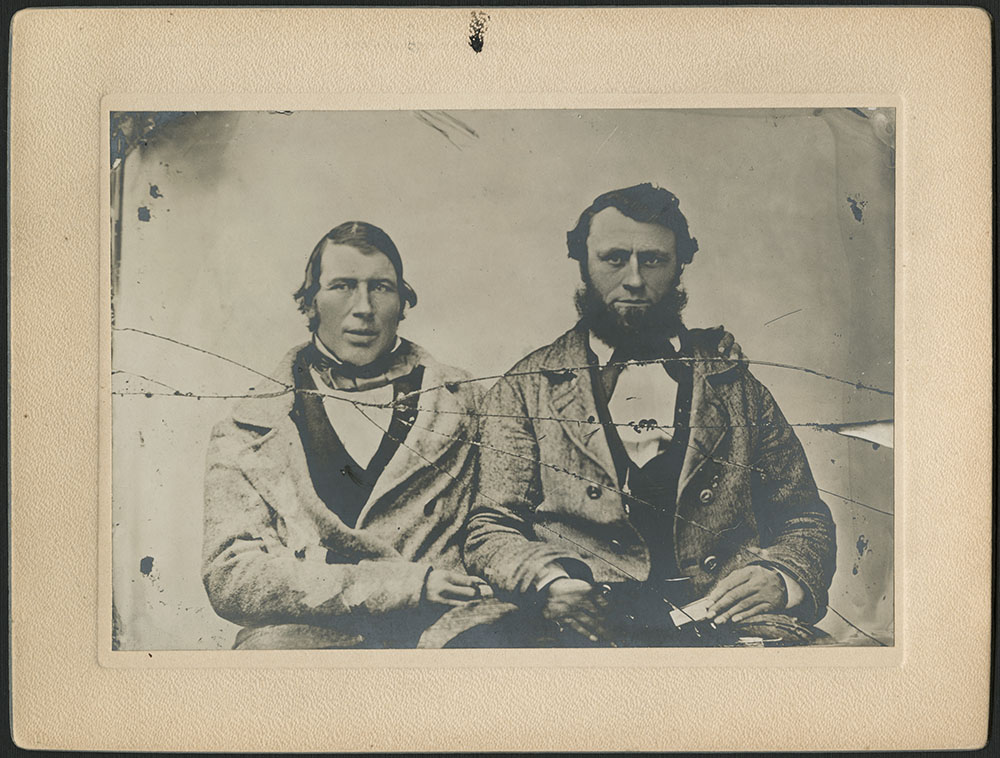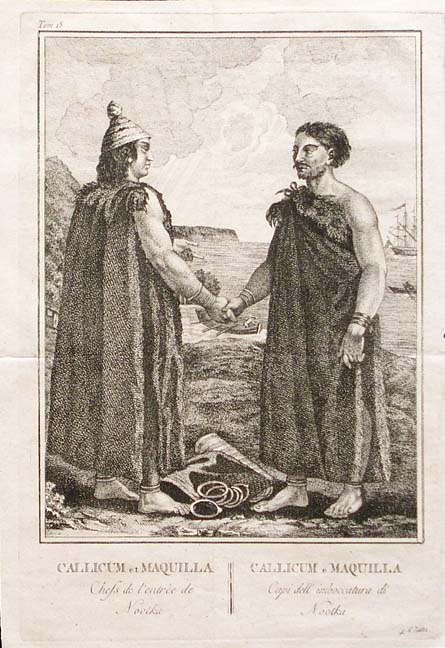Browse "Indigenous People"
-
Article
Jean-Louis Riel
Jean-Louis Riel (also known as Louis Riel Sr.), Métis leader, farmer, miller (born in 1817 in Île-à-la-Crosse, Saskatchewan; died in 1864 in Saint-Boniface, Manitoba). Riel rallied hundreds of Métis people in support of Métis defendants against the Hudson’s Bay Company in the 1849 Sayer trial. A landmark case in the history of the Canadian West, the Sayer verdict re-established free fur trade in the Red River Colony. By the 1850s, Jean-Louis Riel had become a leader of the French-Canadian community in the Red River. His role in having the French language used in the Assiniboia courts, and in gaining representation for the Métis on the Council of Assiniboia, helped to cement this status. Riel’s outspoken stance on Métis rights and autonomy significantly influenced his son, Louis Riel, who went on to become arguably the most significant historical Métis leader.
"https://d2ttikhf7xbzbs.cloudfront.net/media/media/3b6c75e4-12c4-4513-9f68-a9f2c32e3071.jpg" // resources/views/front/categories/view.blade.php
https://d2ttikhf7xbzbs.cloudfront.net/media/media/3b6c75e4-12c4-4513-9f68-a9f2c32e3071.jpg
-
Article
Jerry Potts
Jerry Potts, or Ky-yo-kosi, meaning "Bear Child," scout, guide, interpreter (b at Ft McKenzie, US 1840; d at Fort Macleod, Alta 14 July 1896).
"https://d2ttikhf7xbzbs.cloudfront.net/JerryPotts.jpg" // resources/views/front/categories/view.blade.php
https://d2ttikhf7xbzbs.cloudfront.net/JerryPotts.jpg
-
Article
Kondiaronk
Kondiaronk, Tionontati chief (born circa 1649; died 2 August 1701 in Montreal, QC). He has been known by several names throughout history, including Gaspar Soiaga, Souoias, Sastaretsi, and Le Rat (the Rat). Kondiaronk was one of the main brokers of the Great Peace of Montreal, signed in 1701. This peace agreement between the French and Haudenosaunee brought to an end almost a century of hostilities marked by atrocities on both sides. (See also Indigenous-French Relations in Canada.)
"https://d2ttikhf7xbzbs.cloudfront.net/Kondiaronk/KondiaronkStamp.jpg" // resources/views/front/categories/view.blade.php
https://d2ttikhf7xbzbs.cloudfront.net/Kondiaronk/KondiaronkStamp.jpg
-
Article
Labrador Archaic
The distinctive tools and weapons of the Labrador Archaic people included narrow spear or dart points with a stemmed base for hafting, flaked stone knives and, in some cases, small scrapers for preparing hides.
"https://development.thecanadianencyclopedia.ca/images/tce_placeholder.jpg?v=e9dca980c9bdb3aa11e832e7ea94f5d9" // resources/views/front/categories/view.blade.php
https://development.thecanadianencyclopedia.ca/images/tce_placeholder.jpg?v=e9dca980c9bdb3aa11e832e7ea94f5d9
-
Article
Deskaheh
Deskaheh (also known as Levi General), Cayuga (Gayogohó:no') chief and speaker of the Six Nations Hereditary Council (born in 1873 on the Six Nations Reserve near Brantford, ON; died on 25 June 1925 at the Tuscarora Reservation, New York). A member of the Longhouse religion, Deskaheh insisted that the Six Nations retain their languages and distinctive culture.
"https://d2ttikhf7xbzbs.cloudfront.net/media/media/17f95d34-9527-484a-990a-1dfca38335bf.jpg" // resources/views/front/categories/view.blade.php
https://d2ttikhf7xbzbs.cloudfront.net/media/media/17f95d34-9527-484a-990a-1dfca38335bf.jpg
-
Article
Lydia Campbell
Lydia Campbell (née Brooks, formerly Lydia Blake, known commonly as “Aunt Lydia”), matriarch, writer (born 1 November 1818 at Hamilton Inlet, Newfoundland Colony; died 29 April 1905 in Mulligan, Newfoundland Colony). Campbell was an Anglo-Inuit matriarch in Labrador. She was the first person from Nunatsiavut to publish her writing. Her “Sketches of Labrador Life,” first published in 1894-95, is a rare autobiography detailing life in 19th-century Labrador. Campbell’s writing recounted the role of women in the period of early European colonization of the area.
"https://development.thecanadianencyclopedia.ca/images/tce_placeholder.jpg?v=e9dca980c9bdb3aa11e832e7ea94f5d9" // resources/views/front/categories/view.blade.php
https://development.thecanadianencyclopedia.ca/images/tce_placeholder.jpg?v=e9dca980c9bdb3aa11e832e7ea94f5d9
-
Article
Maquinna
Maquinna, or Mukwina, meaning "possessor of pebbles", was a Nuu-chah-nulth (Nootka) chief (fl. 1778-95). Maquinna was the ranking leader of the Moachat group of Nootka Sound Indigenous peoples on the west coast of Vancouver Island during the early years of European contact.
"https://d2ttikhf7xbzbs.cloudfront.net/media/media/0e25e8d6-1ac5-4a3e-a0a1-2b008d46ae99.jpg" // resources/views/front/categories/view.blade.php
https://d2ttikhf7xbzbs.cloudfront.net/media/media/0e25e8d6-1ac5-4a3e-a0a1-2b008d46ae99.jpg
-
Article
Mary Brant (Konwatsi'tsiaiénni)
Mary Brant, Kanyen'kehà:ka (Mohawk), Haudenosaunee (Iroquois) leader, Loyalist, diplomat, political activist (generally known as Molly Brant and as Konwatsi'tsiaiénni in the Mohawk language, meaning “someone lends her a flower”) (born circa 1736; died 16 April 1796 in Kingston, ON). Brant was one of the most important Indigenous women in Canadian history. From her influential position as head of a society of Six Nations matrons, she enjoyed a much greater status within the Mohawk nation than her more colourful, younger brother, Mohawk leader Joseph Brant. Consulted by Indigenous people on matters of importance, she was a powerful ally to the British forces and served as their highly effective intermediary with the Iroquois in the American Revolutionary War (1775–1783).
"https://d2ttikhf7xbzbs.cloudfront.net/media/media/8fdb5086-619a-4ea0-b146-995510eff36c.jpg" // resources/views/front/categories/view.blade.php
https://d2ttikhf7xbzbs.cloudfront.net/media/media/8fdb5086-619a-4ea0-b146-995510eff36c.jpg
-
Article
Matonabbee
Matonabbee, Chipewyan leader (born circa 1737 in Prince of Wales Fort; died there in August 1782).
"https://development.thecanadianencyclopedia.ca/images/tce_placeholder.jpg?v=e9dca980c9bdb3aa11e832e7ea94f5d9" // resources/views/front/categories/view.blade.php
https://development.thecanadianencyclopedia.ca/images/tce_placeholder.jpg?v=e9dca980c9bdb3aa11e832e7ea94f5d9
-
Article
Mica Bay Incident
In November 1849, a force of Anishinaabeg (see Ojibwe) and Métis warriors, led by Chiefs Oshawano, Shingwaukonse and Nebenaigoching, forced the Quebec and Lake Superior Mining Association to stop operating at Pointe aux Mines, Mica Bay, Lake Superior. Mica Bay is approximately 100 km northwest of Sault Ste. Marie (by road) on Lake Superior. The closure of the mine and the reaction of the Canada West authorities are known as the Mica Bay Incident.
"https://d2ttikhf7xbzbs.cloudfront.net/media/new_article_images/MicaBayIncident/Mica_Bay_c1850.jpg" // resources/views/front/categories/view.blade.php
https://d2ttikhf7xbzbs.cloudfront.net/media/new_article_images/MicaBayIncident/Mica_Bay_c1850.jpg
-
Article
Michel Cadotte
Michel Cadotte, pioneer fur trader, interpreter, mediator (born 22 July 1764 in Sault Ste. Marie, Michigan; died 8 July 1837 in La Pointe, Wisconsin). Cadotte established a large, successful fur trade along the south shore of Lake Superior, which covered present-day northern Wisconsin and extended into parts of northern Minnesota. Half French Canadian and half Ojibwe, he endeared himself to the Indigenous people of the area by marrying Ikwesewe, the daughter of an Ojibwe chief, and by his compassionate understanding of Indigenous ways. These factors allowed Cadotte to gain a monopoly on the fur trade with the Indigenous peoples of the area.
"https://d2ttikhf7xbzbs.cloudfront.net/MichelCadotte/MadelineIslandPic.jpg" // resources/views/front/categories/view.blade.php
https://d2ttikhf7xbzbs.cloudfront.net/MichelCadotte/MadelineIslandPic.jpg
-
Article
Nebenaigoching
Nebenaigoching (also spelled Nebenaigooching, Unbenegooching, or Nabunagoging), or Joseph Sayers, Anishinaabeg Ogima or leader (born c. 1808 at Leech Island, Lake Superior, Upper Canada [ON]; died 1899 at Garden River First Nation, ON). Son of Ogima Waubejechauk (Wabechechacke) and Julia Sayer, Nebenaigoching was a hereditary Crane Clan chief, defender of Anishinaabeg (see Ojibwe) rights, and signatory to the 1850 Robinson-Huron Treaty (see Treaties with Indigenous Peoples in Canada).
"https://d2ttikhf7xbzbs.cloudfront.net/media/new_article_images/Nebenaigoching/Chippewa_Indian_Chiefs_At_Montreal_1849_image.jpg" // resources/views/front/categories/view.blade.php
https://d2ttikhf7xbzbs.cloudfront.net/media/new_article_images/Nebenaigoching/Chippewa_Indian_Chiefs_At_Montreal_1849_image.jpg
-
Article
Ounanguissé
Ounanguissé (“Shimmering Light of the Sun,” also spelled Onangizes, Onanguisset and Onanguicé) was wkama (leader) of the Potawatomi ca. 1660s–1701. He was an important figure in the alliance between the French and Indigenous people of the Great Lakes region during the late 17th and early 18th centuries. He is most well known for a speech he gave regarding this alliance during a meeting he had with the governor general of New France, Louis de Buade de Frontenac in 1697. He also made an important contribution to the establishment of the Great Peace of Montreal in 1701.
"https://development.thecanadianencyclopedia.ca/images/tce_placeholder.jpg?v=e9dca980c9bdb3aa11e832e7ea94f5d9" // resources/views/front/categories/view.blade.php
https://development.thecanadianencyclopedia.ca/images/tce_placeholder.jpg?v=e9dca980c9bdb3aa11e832e7ea94f5d9
-
Article
Culture of Early Indigenous Peoples in Canada
The arrival of early Indigenous peoples in Canada has varying explanations both outside of and within the field of archaeology (see History of Early Indigenous Peoples in Canada). Many Indigenous Oral Traditions state that Indigenous peoples have been on the land that is now known as North America since time immemorial. There is a debate within the field of archaeology on the first arrival of early Indigenous peoples, with dates ranging from as recently as 12,000 years ago to as long ago as 130,000 years ago.
"https://d2ttikhf7xbzbs.cloudfront.net/media/media/f28e80bc-14da-4c69-b71c-6e16f91ed72d.jpg" // resources/views/front/categories/view.blade.php
https://d2ttikhf7xbzbs.cloudfront.net/media/media/f28e80bc-14da-4c69-b71c-6e16f91ed72d.jpg
-
Article
Peter Tomkins
Peter Tomkins Jr., Métis leader, political organizer, blacksmith (born 1 January 1899 in Poundmaker Reserve, SK; died June 1970 in High Prairie, AB). In the 1930s, he worked with Jim Brady and Malcolm Norris to build the Métis Association of Alberta (founded 1932, now the Métis Nation of Alberta) and the Indian Association of Alberta (1939). From health care to his work with the Métis settlements, Tomkins promoted improved living conditions for the Métis of Alberta and Saskatchewan. His diplomacy, lobbying and negotiating skills helped get the first Métis-specific legislation passed in Canada in 1938.
"https://development.thecanadianencyclopedia.ca/images/tce_placeholder.jpg?v=e9dca980c9bdb3aa11e832e7ea94f5d9" // resources/views/front/categories/view.blade.php
https://development.thecanadianencyclopedia.ca/images/tce_placeholder.jpg?v=e9dca980c9bdb3aa11e832e7ea94f5d9
